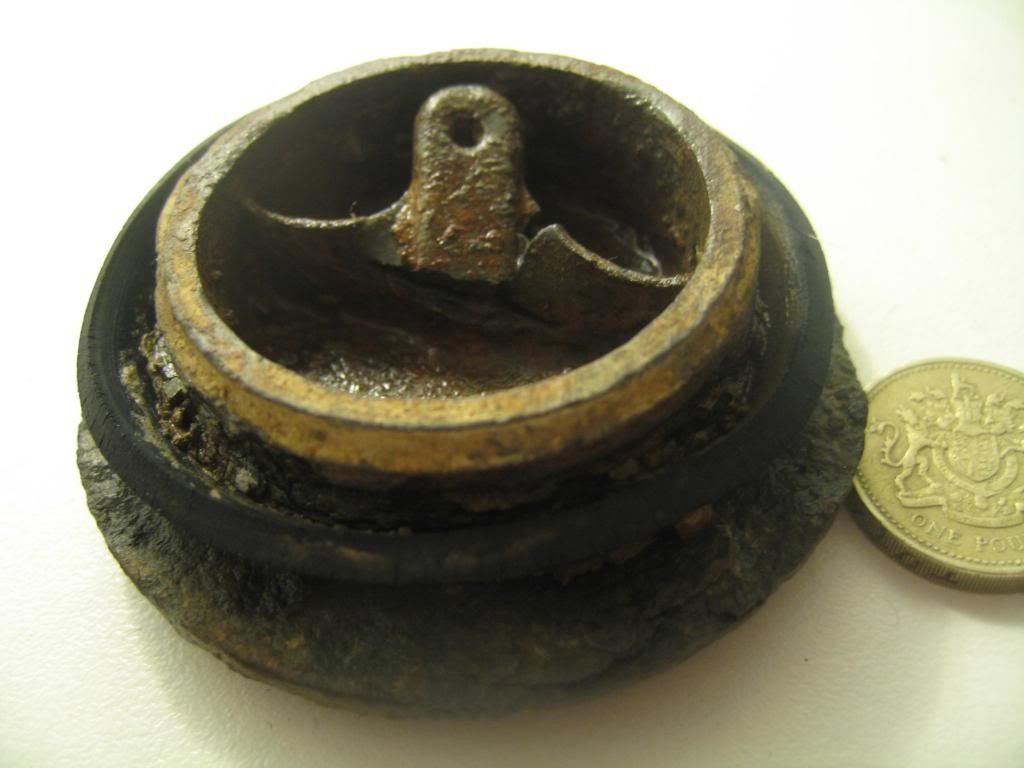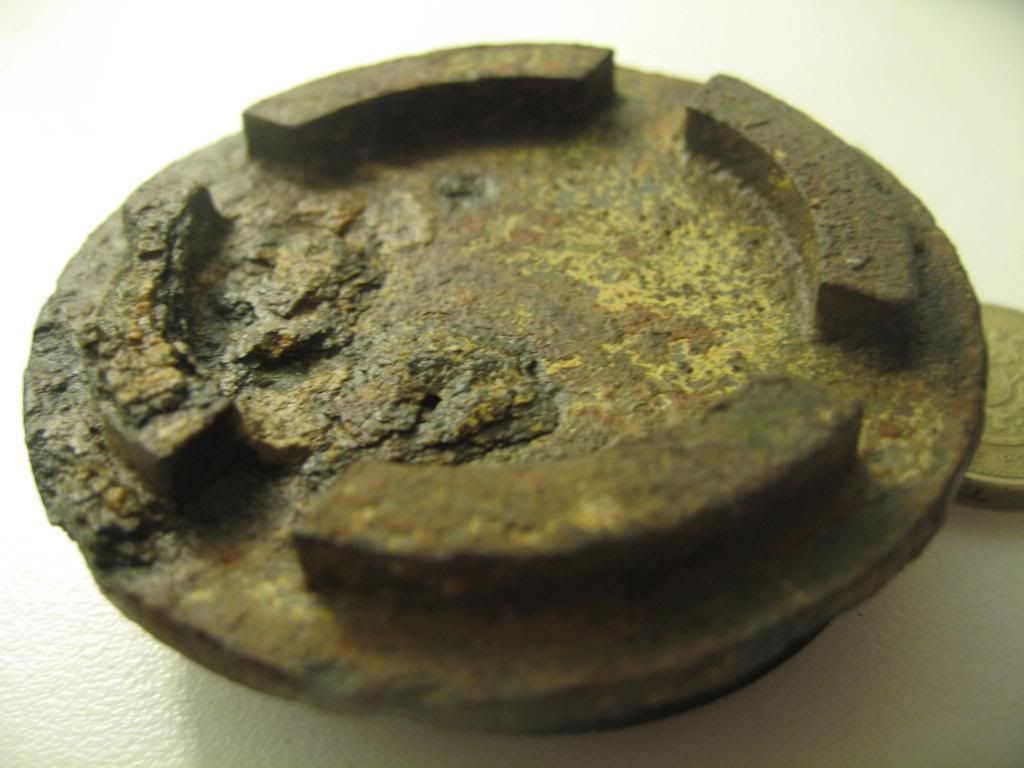British Ordnance Collectors Network
You are using an out of date browser. It may not display this or other websites correctly.
You should upgrade or use an alternative browser.
You should upgrade or use an alternative browser.
V2 rocket part?
- Thread starter Ringo
- Start date
continuing the research. A V2 defiinitely came down there according to this site:
http://www.v2rocket.com/start/deployment/timeline.html
more evidence?:
loads of this. Photographed wet:


http://www.v2rocket.com/start/deployment/timeline.html
more evidence?:
loads of this. Photographed wet:


update. Someone may find information useful
Traced these
V-2 Power Plant and Rocket Engine Drawings, 1943-1945Title: V-2 Power Plant and Rocket Engine Drawings, 1943-1945Phy. Description: 1.09 cubic feet (1 records center box)Bio / His Notes: The V-2 was a short-range ballistic missile designed by Germany for use against Southern England in 1944-45. The missile carried a 2000 lb. (910 kg) conventional warhead at supersonic speeds. The vehicle was fueled with sufficient alcohol and liquid oxygen for c.65 seconds of powered flight, giving a maximum range, including unpowered ballistic trajectory, of c.220 miles (352 km). A number of V-2s were captured intact by the Allies and used for rocketry experiments in the late 1940s. In addition, the V-2 design team, headed by Werner on Braun, was captured by the United States Army and returned to the United States, where it formed the core of the Army Ballistic Missile Agency and National Aeronautics and Space Administration launch vehicle design teams.Summary: This collection consists of engineering drawings for the V-2. The material consists of a complete set of production blueprints for the V-2 rocket powerplant and directly related accessories. The drawings are identified as 'Engineering Records File Copy' (in English).General Note: Access note: Only eight of the drawings have been translated.Restrictions: No restrictions on accessSubject-Topical: Ballistic missilesV-2 rocketRocketryAeronautics, MilitaryWorld War, 1939-1945Rockets (Aeronautics)AeronauticsSubject-Name: Von Braun, Wernher, 1912-1977Form / Genre: DrawingsBlueprintsRepository Loc: National Air and Space Museum, Archives Division, MRC 322, Washington, DC, 20560Local Number: 1987-0089
at The Smithsonian and still trying to find out whether I can access info online
got here so far:
http://www.nasm.si.edu/research/arch/
they say on site: we'll be happy to help.
Photos here:
http://www.v2rocket.com/start/others/iwm.html
Re colours, haven't found anything specific except the numbered part is sprayed matt black
http://www.v2rocket.com/start/makeup/markings.html
[SIZE=-1]SCHEME 1 - The Gebatikt (Batiked) pattern, using 5 colors: Cream White, Earth Grey, Oxide Red, Olive Green and Chocolate Brown. This scheme was sprayed and was simular to many traditional camouflage patterns.[/SIZE]
[SIZE=-1]SCHEME 2 - The Geflammt (Wavy) pattern, using only three colors: Cream White, Earth Grey and Olive Green.[/SIZE]
[SIZE=-1]SCHEME 3 - The Gezackt (Ragged) pattern, using the same three colors as scheme 2. Actually, there were two versions of this ragged scheme. The second version bacame the most popular, and was adopted in March of 1944. Cream White was replaced with Signal White and the ragged pattern simplified. Of the surviving photographs showing A4/V2 rockets using the ragged camouflage scheme, the majority of these are the later ragged scheme-[/SIZE]
[SIZE=-1]Later, during the last months of the war, A4/V2 rockets were painted a solid color of RAL 7009 Greenish-Gray or Grn/Grau (Official German document about RAL-7009 is the "Bauzustand" from January 1945 - Olaf Przybilski).[/SIZE]
[SIZE=-1]The colors were the same colors used by the German Army throughout WWII. The eight RAL Reichsausschuss fr Lieferbedingungen (Government Committee for Specifications) colors were identified by number as:[/SIZE]
Traced these
V-2 Power Plant and Rocket Engine Drawings, 1943-1945Title: V-2 Power Plant and Rocket Engine Drawings, 1943-1945Phy. Description: 1.09 cubic feet (1 records center box)Bio / His Notes: The V-2 was a short-range ballistic missile designed by Germany for use against Southern England in 1944-45. The missile carried a 2000 lb. (910 kg) conventional warhead at supersonic speeds. The vehicle was fueled with sufficient alcohol and liquid oxygen for c.65 seconds of powered flight, giving a maximum range, including unpowered ballistic trajectory, of c.220 miles (352 km). A number of V-2s were captured intact by the Allies and used for rocketry experiments in the late 1940s. In addition, the V-2 design team, headed by Werner on Braun, was captured by the United States Army and returned to the United States, where it formed the core of the Army Ballistic Missile Agency and National Aeronautics and Space Administration launch vehicle design teams.Summary: This collection consists of engineering drawings for the V-2. The material consists of a complete set of production blueprints for the V-2 rocket powerplant and directly related accessories. The drawings are identified as 'Engineering Records File Copy' (in English).General Note: Access note: Only eight of the drawings have been translated.Restrictions: No restrictions on accessSubject-Topical: Ballistic missilesV-2 rocketRocketryAeronautics, MilitaryWorld War, 1939-1945Rockets (Aeronautics)AeronauticsSubject-Name: Von Braun, Wernher, 1912-1977Form / Genre: DrawingsBlueprintsRepository Loc: National Air and Space Museum, Archives Division, MRC 322, Washington, DC, 20560Local Number: 1987-0089
at The Smithsonian and still trying to find out whether I can access info online
got here so far:
http://www.nasm.si.edu/research/arch/
they say on site: we'll be happy to help.
Photos here:
http://www.v2rocket.com/start/others/iwm.html
Re colours, haven't found anything specific except the numbered part is sprayed matt black
http://www.v2rocket.com/start/makeup/markings.html
[SIZE=-1]SCHEME 1 - The Gebatikt (Batiked) pattern, using 5 colors: Cream White, Earth Grey, Oxide Red, Olive Green and Chocolate Brown. This scheme was sprayed and was simular to many traditional camouflage patterns.[/SIZE]
[SIZE=-1]SCHEME 2 - The Geflammt (Wavy) pattern, using only three colors: Cream White, Earth Grey and Olive Green.[/SIZE]
[SIZE=-1]SCHEME 3 - The Gezackt (Ragged) pattern, using the same three colors as scheme 2. Actually, there were two versions of this ragged scheme. The second version bacame the most popular, and was adopted in March of 1944. Cream White was replaced with Signal White and the ragged pattern simplified. Of the surviving photographs showing A4/V2 rockets using the ragged camouflage scheme, the majority of these are the later ragged scheme-[/SIZE]
[SIZE=-1]Later, during the last months of the war, A4/V2 rockets were painted a solid color of RAL 7009 Greenish-Gray or Grn/Grau (Official German document about RAL-7009 is the "Bauzustand" from January 1945 - Olaf Przybilski).[/SIZE]
[SIZE=-1]The colors were the same colors used by the German Army throughout WWII. The eight RAL Reichsausschuss fr Lieferbedingungen (Government Committee for Specifications) colors were identified by number as:[/SIZE]
smle2009
Well-Known Member
Hi Ringo,
The more I look at your first two photo's,the more they remind me of one of a pair of oil seal retainers like you would get on a crank/timing chain case for the top/crank pully on a large engine such as a lorry,tank ect.
Don't know the first thing about pulse engines but if they had a 'drive' of some sort going through a casing it could be a place to look for an id of your part?
A.T.B
Tony
The more I look at your first two photo's,the more they remind me of one of a pair of oil seal retainers like you would get on a crank/timing chain case for the top/crank pully on a large engine such as a lorry,tank ect.
Don't know the first thing about pulse engines but if they had a 'drive' of some sort going through a casing it could be a place to look for an id of your part?
A.T.B
Tony
The first item reminds me more or less a bearing shell half / shaft seal housing half rather than a rocket part. Also the marking sounds more British than German.
The second item might be of German origin - as well as anything else.
Third item, no comments.
The second item might be of German origin - as well as anything else.
Third item, no comments.
Thanks very much for the replies. Went back to the site but only managed to pick up loads of aluminium (rather than brass) so no proof yet. Will try again soon
The Smithsonian replied with the below which surprised me since their online catalogue states they have the documents:
I have spoken with our curator for German rockets, and unfortunately, we have no way of tracking V-2 part numbers. You may wish to try contacting the Imperial War Museum, though we are not sure they would have any information:
UK: Imperial War Museum (Duxford)
Duxford Airfield
Cambridge CB2 4QR
United Kingdom
Phone: 0223 035000
URL: www.iwm.org.uk/duxford.htm
Online contact form: http://www.iwm.org.uk/server/show/nav.64
Thank you for your interest in the National Air and Space Museum.
The Smithsonian replied with the below which surprised me since their online catalogue states they have the documents:
I have spoken with our curator for German rockets, and unfortunately, we have no way of tracking V-2 part numbers. You may wish to try contacting the Imperial War Museum, though we are not sure they would have any information:
UK: Imperial War Museum (Duxford)
Duxford Airfield
Cambridge CB2 4QR
United Kingdom
Phone: 0223 035000
URL: www.iwm.org.uk/duxford.htm
Online contact form: http://www.iwm.org.uk/server/show/nav.64
Thank you for your interest in the National Air and Space Museum.
Chris 42 RQ
Well-Known Member
Pipe work fitting perhaps ?
The first item may be a fuel line connector as there would have been a lot of pipework in one of these bombs.
As for the rest of the items I have no idea.
Interesting finds !
The first item may be a fuel line connector as there would have been a lot of pipework in one of these bombs.
As for the rest of the items I have no idea.
Interesting finds !
Last edited:
Chris 42 RQ
Well-Known Member
The last picture looks like it may well be a "Plate" froma small Lead acid battery.
The two other items may just conceivably be capacitors ?
The two other items may just conceivably be capacitors ?
Cheers, Chris! Would agree with the plate idea, thanks. Any idea what would need a small, lead acid battery?
Capacitors is a good suggestion, too! Awfully big?
Here's a couple of other things that may be parts. The first one is a broken letter A
The second I thought was a part of a fuze but it has a rubber ring to hold in pressure
Any ideas?




Capacitors is a good suggestion, too! Awfully big?
Here's a couple of other things that may be parts. The first one is a broken letter A
The second I thought was a part of a fuze but it has a rubber ring to hold in pressure
Any ideas?




Chris 42 RQ
Well-Known Member
The last item looks very much like a petrol can filler cap probably made from a zinc compound judguing by the corrosion.
A sfor the broken "A" what material is it made from please???
A sfor the broken "A" what material is it made from please???
#8 i think is the top of a flower pot used in grave yards
#8 i think is the top of a flower pot used in grave yards
Agreed, millsbomber. I should have taken that photo off. I took it off my website
















